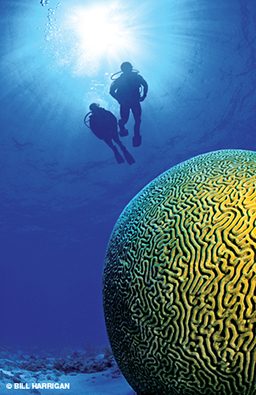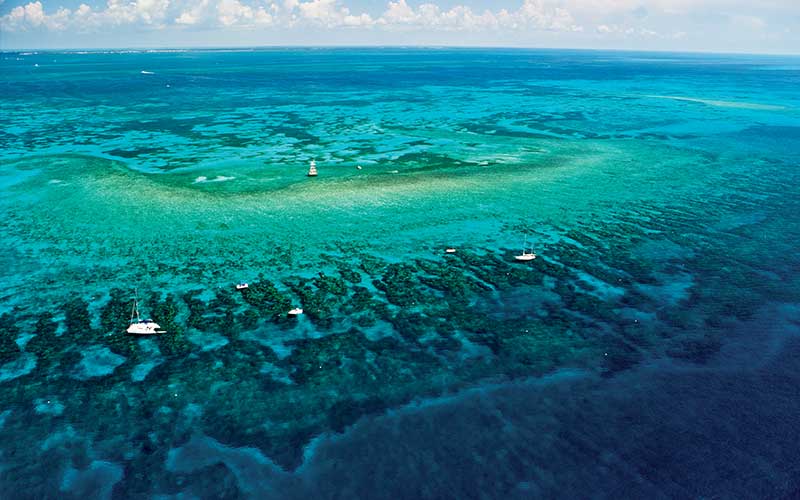Simply say the word “Pennekamp,” and visions of coral reefs and colorful fish instantly fill most divers’ minds. The park name is now iconic, but John Pennekamp Jr. says no one was more surprised than his father when on Dec. 10, 1960, Gov. LeRoy Collins stood up at the dedication and announced the park name as . “The governor and other park board members decided on the name the night before,” Pennekamp said. “My father considered himself first and foremost a newspaperman. He had no idea the park was going to be named for him.”
It was an appropriate honor, though, because the elder Pennekamp was a persistent force behind the formation of the park. It was Pennekamp who persuaded the prominent Crane and Shaw families to donate the land for the park, and it was Pennekamp who convinced the U.S. Army Corps of Engineers to dredge South Sound Creek and the channel now known as the Bowling Alley. He helped Gov. Collins and Assistant Secretary of the Interior Ross Leffler coax the federal government into extending Florida state authority beyond the usual three-mile offshore limit; the limit was extended to the 60-foot isobaths, almost eight miles offshore.

Pennekamp inspired other people, too, like Ellison Hardee, the first superintendent of the park who worked on the placement of the famous Christ of the Abyss statue. When the statue arrived in Florida in 1965, he had to haul it down from Ft. Lauderdale himself. Hardee, Assistant Superintendent Johnny Johnston and a staff of four rangers formed and poured the statue’s layered-concrete base right there in the park. The slabs were then loaded on a barge for the trip out to Key Largo Dry Rocks. “We were lucky with the weather,” Hardee said, “but the water was so flat and the tide so high, we had a hard time finding the reef. Back then you had to look for the breakers, but it was like glass.” Positioning the 20,000-pound base and fastening the 4,000-pound statue to it by hand turned the two-day project into three days, but the barge’s owner donated the extra time. Hardee can laugh about it now. “We didn’t know we couldn’t do it,” he says, “so we did it.”
Since Hardee’s tenure, a dozen or so superintendents have taken their turn at the park’s helm over the years, including current superintendent Pat Wells. But the park caretakers have not worked alone; other important contributions have been made by people working in the background, including those who led a 15-year campaign to acquire vital lands adjacent to the park. Former district biologist Renate Skinner says, “Imagine a monkey farm on Rodriguez Key, high-density housing all along north Key Largo and huge marinas at Port Bougainville and Carysfort. Those were all in the plans.” What travelers see instead are miles of pristine coastline preserving the park’s water quality, thanks to Skinner and people like Greg Brock, then a lead staffer of the Conservation and Recreation Lands program.
In 1972, the Eisenhower-era deal for extended-state jurisdiction fell apart, and the Key Largo National Marine Sanctuary was quickly designated to restore protection to Pennekamp’s outer reefs. One of the first successes of the new state/federal partnership was the development of embedded-anchor mooring buoys by biologist John Halas. Halas’ elegant mooring system dramatically reduced anchor damage to the fragile coral and made it easy for divers to access the best dive sites.
The larger Florida Keys National Marine Sanctuary superseded the Key Largo sanctuary in 1990, yielding even more protective measures. Until the formation of the larger sanctuary, southbound ships were a common sight to divers, hugging the reefs in order to stay out of the northbound current of the Gulf Stream. The problem was that some ships cut right through the dive boat moorings, while others ran hard aground. With Pennekamp’s famous reefs now nestled within the bigger sanctuary, large ships were finally required to stay in deeper water. Special zones called “sanctuary preservation areas” were also established around Molasses, French, the Elbow and Carysfort, eliminating conflicts between fishermen and divers while simultaneously boosting reef fish populations.
Since it opened 50 years ago, almost 30 million people have visited Pennekamp Park. We keep coming with our masks and fins, our snorkels and tanks at a rate of nearly one million per year. John D. Pennekamp may have been proudest of defending freedom of the press, but his name lives on in Pennekamp Park.

© Alert Diver — Q1 Winter 2011